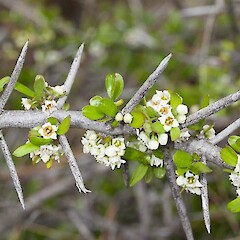Discaria toumatou
Common name
matagouri, tūmatakuru
Synonyms
None
Family
Rhamnaceae
Flora category
Vascular – Native
Endemic taxon
Yes
Endemic genus
No
Endemic family
No
Structural class
Trees & Shrubs - Dicotyledons
NVS code
The National Vegetation Survey (NVS) Databank is a physical archive and electronic databank containing records of over 94,000 vegetation survey plots - including data from over 19,000 permanent plots. NVS maintains a standard set of species code abbreviations that correspond to standard scientific plant names from the Ngä Tipu o Aotearoa - New Zealand Plants database.
DISTOU
Chromosome number
2n = 22
Current conservation status
The conservation status of all known New Zealand vascular plant taxa at the rank of species and below were reassessed in 2017 using the New Zealand Threat Classification System (NZTCS) – more information about this can be found on the NZTCS website. This report includes a statistical summary and brief notes on changes since 2012 and replaces all previous NZTCS lists for vascular plants.
Please note, threat classifications are often suggested by authors when publications fall between NZTCS assessment periods – an interim threat classification status has not been assessed by the NZTCS panel.
- Conservation status of New Zealand indigenous vascular plants, 2017 . 2018. Peter J. de Lange, Jeremy R. Rolfe, John W. Barkla, Shannel P. Courtney, Paul D. Champion, Leon R. Perrie, Sarah M. Beadel, Kerry A. Ford, Ilse Breitwieser, Ines Schönberger, Rowan Hindmarsh-Walls, Peter B. Heenan and Kate Ladley. Department of Conservation. Source: NZTCS and licensed by DOC for reuse under the Creative Commons Attribution 4.0 International licence.
2017 | At Risk – Declining
Previous conservation statuses
2012 | Not Threatened
2009 | Not Threatened
2004 | Not Threatened
Brief description
Spiky grey shrub with many zig-zagging long flexible twigs bearing long (up to 5cm long) green spines interspersed with small oval dark green leaves. Bark rough, broken into squares. Leaves 10–20mm long. Flowers small, white, inconspicuous. Fruit a dry, 3 sided capsule.
Distribution
Endemic. North Island (from near Waiuku south to the southern Wairarapa and Wellington coastline; very uncommon), South Island (mainly east of the main divide, appearing to avoid areas of high rainfall).
Wetland plant indicator status rating
Information derived from the revised national wetland plant list prepared to assist councils in delineating and monitoring wetlands (Clarkson et al., 2021 Manaaki Whenua – Landcare Research Contract Report LC3975 for Hawke’s Bay Regional Council). The national plant list categorises plants by the extent to which they are found in wetlands and not ‘drylands’. The indicator status ratings are OBL (obligate wetland), FACW (facultative wetland), FAC (facultative), FACU (facultative upland), and UPL (obligate upland). If you have suggestions for the Wetland Indicator Status Rating, please contact: [Enable JavaScript to view protected content]
UPL: Obligate Upland
Rarely is a hydrophyte, almost always in uplands (non-wetlands).
Flower colours
White
Life cycle
Seeds are dispersed by ballistic projection and water (Thorsen et al., 2009).
Propagation technique
Easy from seed. Can be grown from cuttings but these can be slow to strike. Rather variable, and some North Island sand dune forms are entirely prostrate, forming trailing shrubs. An excellent hedge plant, with the added bonus that this species fixes atmospheric nitrogen, making it available for other plants.
Threats
Although abundant and probably stable in much of its South Island range, Discaria toumatou has become very uncommon and is under threat throughout the North Island, where it is now known from very few sites and viable populations. Reasons for the decline are not specified but loss of habitat is likely to be a major factor.
Etymology
discaria: Disc bearing
toumatou: Derived from the Maori name tumamatakuru.
Where To Buy
Occasionally available from specialist native plant nurseries.
References and further reading
Chrystall L. 1976. Further record of matagouri in the North Island. Wellington Botanical Society Bulletin 39: 47.
Duguid F. 1976. Matagouri at Herbertville. Wellington Botanical Society Bulletin 39: 45.
Elder NL. 1966. Matagouri in the North Island. Wellington Botanical Society Bulletin 33: 5.
Elder NL. 1967. Matagouri in the North Island – Part 2. Wellington Botanical Society Bulletin 34: 19–20.
Moorfield JC. 2005. Te Aka : Māori-English, English-Māori dictionary and index. Longman/Pearson Education, Auckland, NZ. 357 p.
Thorsen MJ, Dickinson KJM, Seddon PJ. 2009. Seed dispersal systems in the New Zealand flora. Perspectives in Plant Ecology, Evolution and Systematics 11: 285–309. https://doi.org/10.1016/j.ppees.2009.06.001.























